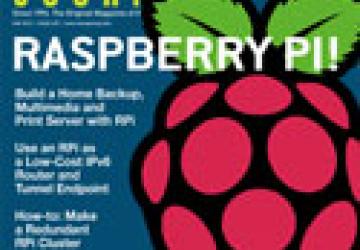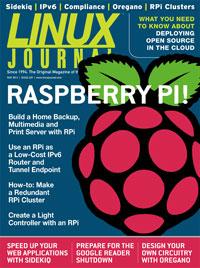May 2013 Issue of Linux Journal: Raspberry Pi


A Pint-Size Powerhouse with a Tasty-Sounding Name
It's hard not to love the Raspberry Pi. For less money that it takes to stop at a drive-through, it's possible to buy the top-end RPi model. (Granted, I have three teenagers, so the drive-through is expensive.) The Raspberry Pi is as open as the manufacturer can make it, has huge community support, and its software isn't backed by a huge corporation with mysterious motivations (cough, Android, cough). It's just a cool little ARM device that runs Linux. This month, we focus on the Raspberry Pi. The drive-through is optional.
Dave Taylor doesn't work directly with a Raspberry Pi this month, but his continuing series on scripting a Cribbage game certainly will work on an RPi. Even if you're not a Cribbage fan, Dave's scripting lessons are infinitely useful for learning. Reuven M. Lerner teaches a thing or two this month as well—specifically in regard to running background tasks in your Web applications. Running things in the background can make a monstrous Web application perform much more quickly from the end user's perspective. Reuven shows how with Sidekiq.
Kyle Rankin, who first interested me in Raspberry Pi devices, talks about redundancy this month. What's better than a Raspberry Pi? Redundant pies—or Pis, rather. If you want to bolster your RPi reliability or just want an inexpensive platform to learn clustering, Kyle walks through the process. I've been writing about my Raspberry Pi adventures off and on for the past six months, so this month, I decided to focus on an issue that is near and dear to my heart: RSS. If the Google Reader shutdown in July has you worried about how you'll browse the Web, perhaps my column will help. I'm past panic mode, and I've been able to wean myself off Google Reader altogether.
I'm probably not the only Linux Journal reader who has a full virtualization system with iSCSI SAN/NAS storage in my basement. Unfortunately, along with that nerdy power comes a big electricity bill. Brian Trapp describes the other end of that spectrum with his article on creating the perfect home server—with a Raspberry Pi. There are plenty of reasons powering your Linux server infrastructure with a cell-phone charger is awesome, and Brian explains how. If you want to add IPv6 to the mix, Igor Partola follows up with an article on creating an IPv6 router on your network, even if your ISP doesn't support it!
I realize all my "servers in the basement" stuff is almost cliché when talking about Linux users. To be fair, I didn't say it was my mom's basement. Still, Jonathan Brogdon's article on controlling stage lighting with a Raspberry Pi is a great way to avoid our basement-dwelling stereotype. Jonathan literally puts RPi in the spotlight with his hardware/software combination for controlling external lighting. It's a real-world solution and really cool to read about.
The coming shutdown of Google Reader has made all of us think a little harder about the dangers of cloud computing. At the very least, it's forced us to think about trusting cloud-based services we don't directly control. Diana Marina Cooper talks about the other end of the cloud—specifically as it relates to open-source compliance. How does the GPL relate to a world of "Software as a Service"? If the cloud obfuscates the software and the code, what does that mean with regards to FOSS? Diana takes a serious look at a problem not many of us consider.
Do you have a Raspberry Pi, and are you looking for something to do with it? Do you already have a rack of clustered-RPi devices in your basement, and are you looking for tips on optimization? Regardless of your immersion level into the Pi, this issue should prove useful and entertaining. Even if you have no interest in the Raspberry Pi, this issue is full of the same tech tips and Linux news you're used to seeing. This issue was incredibly fun to put together, and we hope you enjoy it as much as we did.
Available to Subscribers: May 1










